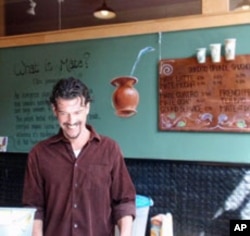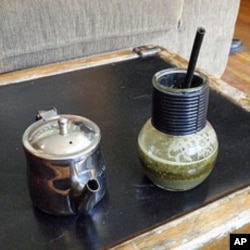It's not quite tea. And it's definitely not coffee.
The traditional South American beverage called yerba mate is still relatively unknown in the U.S. But it's becoming more and more prevalent in natural food stores and cafes.
Next big thing?
The Top Leaf Mate Bar in downtown Bend, regon looks a lot like your average coffee shop. But there's no coffee on the menu here.
The baristas are exclusively serving products made with yerba mate. That's a large shrub grown in countries like Argentina and Paraguay. The leaves are dried and steeped in either hot or cold water to make a beverage that's kind of like tea.
But Top Leaf customer Len Meserve is nursing a mug holding something that looks more like a fancy frothy coffee. It's called a mocha mate.
"It's mate and chocolate and it's very good," says Meserve.
Another popular drink is the mate latte. Customer Alex Monshaw made the switch from coffee to mate several months ago. He used to drink up to four cups of coffee a day. Not anymore.
"The cool thing about it is, it's not like if I miss a day of mate I'm pissed off all day, like coffee was, you know," says Monshaw. "When you miss your coffee, it's really unpleasant but mate isn't something I need to wake up. It's just something that makes me feel really good."
Feeling good
Top Leaf owner Santiago Casanueva is practically evangelistic in his support of mate. He wants to turn the mate bar concept into a franchised chain. But he doesn't expect to displace Americans' coffee anytime soon:
"Coffee's had a strong run for 20 years. It's going to keep being here," says Casanueva. "I educate my customers in a way that allows them to realize they're making, not only a choice that's giving them the same buzz if not better, but they're getting all these nutritional benefits."
Those nutritional benefits vary, depending on who you ask. Jennifer Nelson is director of clinical nutrition at the Mayo Clinic in Rochester, Minnesota. She says mate does have disease-fighting antioxidants along with nutrients like calcium, iron and Vitamin C.
"However, the total amount of those nutrients and the total amount of these antioxidants are relatively small in comparison to other foods," she says. "And so you need to kind of put it in perspective."
According to Nelson, mate does contain a small amount of caffeine, but much of its boost comes from other natural stimulants. She says mate, like other caffeinated beverages, is best consumed in moderation.
Going big
Moderation is the furthest thing from Oregon entrepreneur Nate Winkler's mind.
Winkler runs Oregon Yerba Mate. He does sell mate by the cup in a small café, but it's around back in his warehouse where the real action is.
Winkler imports mate from Argentina and adds herbs and spices in a customized blending machine that looks kind of like a cement mixer. Winkler says even his most creative concoctions are still about 95 percent mate.
But he says the flavored blends are a way to make it appeal to a wider audience. "Mate has a pretty bitter taste, especially drinking it traditional style. So for the American palate, it's really hard to handle that way."
Mixing in other flavors isn't the only concession to North American preferences that Winkler and other mate purveyors have made.
Shared experience
In South America, mate is a shared experience, almost a ritual. You drink it out of a gourd through a metal straw called a bombilla. A server pours water over the mate leaves, enough for a single serving. You drink it, and pass it back to the server, who does the same thing for the person next to you. The gourd goes around the circle, everyone drinking out of the same straw.
Winkler says he drank mate that way when he was in South America with the Peace Corps. But he's not sure most of his customers are ready for that.
"If people were more receptive to that kind of thing, I would obviously be way bigger on it," says Winkler. "But we're in America and it's fast-paced, you know, get your drink and go. It's going to be hard to get a bunch of people to come into my café and sit around and share a gourd."
Back at the Top Leaf Mate Bar in Bend, Santiago Casanueva says about 10 percent of his customers choose to share a gourd. Len Meserve is not one of them. He knows about the traditional way of drinking mate, but says while the shared experience has its attraction, he'd rather just go it alone:
"It's just more convenient to have your own," says Meserve. "You get to control it. We seem to like that aspect."
In addition to the convenience of drinking mate out of a cup, there's also the "yuck" factor. In a germ-phobic society, sharing a straw doesn't have much appeal.













